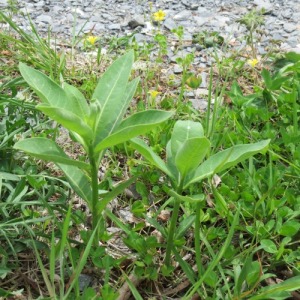Not all plants are born equal. Some go through their entire life cycle with nary a glance from passersby. Take, for instance, the plants that grow on bare ground and other hostile places with poor soil and few nutrients. To survive, these plants have developed special adaptations such as long tap roots and root nodes containing nitrogen-fixing bacteria. Some have thorns and a bitter taste as an added layer of protection. These plants grow, propagate, and die, and in the process enrich and stabilize the soil, paving the way for other, less hardy, plants to grow. These early soil colonizers are the ‘pioneer plants’ — otherwise disparagingly referred to as “weeds.”
Common mullein, also known as Aaron’s Rod or Adam’s Flannel, thrives in poor soil or areas where the soil is disturbed. A biennial, the first year it grows in a rosette with large, silvery-green, flannel-like leaves. The leaves are spread in a circle, shading the plant stem and roots and maximizing the sun. The rosette lives through the winter and in its second season, sends up a stalk with yellow flowers that bloom from June through September.
Although mullein is non-native, some gardeners allow it to grow because it is drought-tolerant, a prolific bloomer, beneficial to bees, and some birds including American goldfinches and indigo buntings eat the seeds. Mullein self-sows freely, but can be controlled by deadheading the flowers to prevent new seedlings.
Common milkweed is another pioneer plant that rarely receives its due praise. Found in fields and pastures, vacant lots, and along woodland borders, this native plays an important role as host plant of the larvae of the monarch butterfly (a declining species in Virginia), and is a highly sought-after nectar source for wasps, bees, butterflies, and beetles.
These young milkweed plants have injudiciously decided to grow in the middle of our lane where their future is a bit precarious, but hundreds come up every year in Butterfly Meadow and elsewhere around the farm.
Pioneer species are often also ‘opportunist’ species which are able to rapidly exploit a sudden new opening in ground plant cover. The seeds of these species arrive, germinate, and grow quickly, rapidly reproducing themselves before other slower-colonizing species arrive to outcompete them.
Dandelions, the bane of the perfect lawn set, fall into this category, but they, too, have a job to do. Their profligate nature and the fact that they are one of the earliest wildflowers in spring make them an important food source for honeybees and butterflies. Honeybees gather the pollen in special pockets and take it back to the hive to feed the colony; butterflies and bees alike drink the nectar for fuel.
Unfortunately, many homeowners and gardeners spend a fortune eradicating these so-called weeds rather than trying to live with them or manage their numbers. We would be wise to remember that when we remove or destroy the fertile top layer of the soil, nature sends in her first line of defense – the weeds!
“A weed is a plant whose virtues have not yet been discovered.”
~Ralph Waldo Emerson
* * * * * * * * *
To find Jo Ann, click here:


